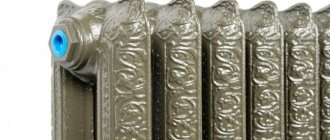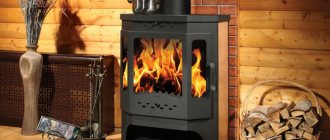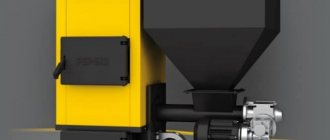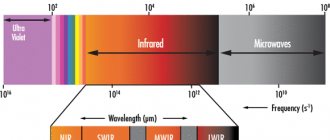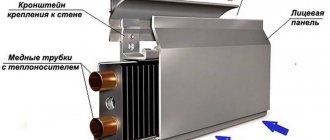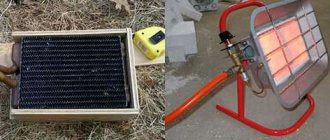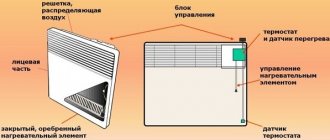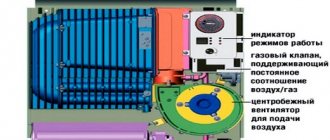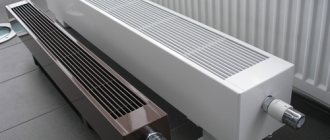An electric convector is a modern, practical device that allows you to provide optimal comfortable temperature and heating in a room. The most popular models are from Neurot, Electrolux, Thermia, Ballu. Electric convectors are characterized by a wide range of advantages compared to central heating radiators. The main tasks of an electric convector:
- The electric convector provides optimal temperature in a room characterized by poor heating;
- Heating with electric convectors where there is no central heating - private houses, cottages, cottages, industrial and commercial premises.
In this article we will talk about electric convectors for heating a private house and apartment from different manufacturers, consider their pros and cons and try to help you choose the best model for your home.
Types of convectors
Electric convectors are classified according to the location of the device and installation features:
- Wall-mounted models of electric convectors are mounted similarly to conventional radiators.
Wall-mounted electric convectors are attached to the wall using a bracket. The device operates on the principle of air convection - warm air rises higher, cold air descends. Modern electric convectors can be equipped with a special fan, thanks to which the power of the device increases by 2 kW.
With the help of a fan, warm air is distributed throughout the room more efficiently, heating occurs faster. You can buy a wall-mounted electric convector for heating a private house or apartment. Thermia electric convectors are suitable for dachas - a practical, inexpensive option. You can get acquainted with the convector models using the video on our website.
Equipping an electric convector with a temperature sensor makes it possible to control and set the optimal air temperature for heating. The thermostat allows you to regulate the heating level of the heating element.
Types of wall-mounted electric convectors:
- Skirting electric models: characterized by compact parameters, with a height of up to 0.2 m they have a power of up to 3 kW. The heat dissipation is small. Suitable for heating small rooms at home, for a larger room - models from 2.5 meters in length are suitable. Suitable for a private house, apartment.
- High: convectors that are mounted under the windowsill of the house, the height of the models is 0.4 - 0.45 m. High level of heat transfer.
It is recommended to install wall-mounted electric convectors under the window opening - this allows you to retain heat in the house. How it works? The convector becomes a barrier to cold air that enters from outside the room - the warm air masses that the convector produces prevent cold air from the street.
- Floor-standing electric convectors are installed on the floor plane of a private house or apartment.
The main advantage of electric models is the ability to install it in any room or home. Floor-standing electric convectors Thermia, Electrolux, Neurot, Zilon, according to reviews, are characterized by mobility, a sufficient level of power for heating different rooms, and affordable prices. Suitable for heating residential and non-residential premises - apartments, offices, boutiques, shops, private houses.
The electric convector is placed so that the warm air flow is directed towards the person. Heating with electric convectors differs in power level. Floor-standing models are equipped with wheels, thanks to which the heater can be moved freely on a smooth floor surface.
In case of overturning, the electric convector automatically turns off - for this purpose the electrical device is equipped with a special sensor. An electric convector for heating a private floor-type house is convenient and portable. Electric convectors Thermia, Electrolux, Zilon are represented by a wide selection of models with different technical characteristics.
- There is a special category of convectors - universal models. The main difference is the ability to install both on the wall and on the floor. Different models of convectors differ in power level. The electric convector is supplied with a special bracket for installation on the wall and legs for placement on the floor.
The best gas convector heaters
Such devices have a “wet” and “dry” operating principle with a heat exchanger inside that retains heat for a long time. Air constantly circulates through the inlets and outlets, distributing heat throughout the room.
Effective for large areas without doors or partitions. Used as main heating. They require installation of a chimney (vertical or horizontal).
Alpine Air NGS-50 - for apartments
This is the best convector-type heater for heating in an apartment that does not have closed rooms, because the estimated operating area of the device is 49 m2. The body has a beautiful, streamlined design that is well suited to the interior of a living space.
Five wide groups of cut strips at the top and bottom of the casing ensure rapid air circulation and heat distribution. Inside there is a heat exchanger made of cast iron, which helps save on blue fuel.
Recommendations: 10 Best Infrared Heaters
10 Best Ceramic Heaters
10 best outdoor heaters
Pros:
- 3 year warranty from Turkish manufacturer;
- interesting design with black corners and snow-white surface of the body;
- the metal casing reliably protects the internal elements;
- the cast iron heat exchanger is made with thick walls that retain heat;
- there is no liquid inside, so the system will not leak and does not need to replace seals;
- compact dimensions 60x22x63 cm will fit under the windowsill or on any short wall;
- safe surface heating temperature of 38 degrees does not cause harm if accidentally touched;
- the system will not freeze during long periods of inactivity;
- heat output is equivalent to 4900 W;
- piezo ignition makes starting easier;
- does not dry out the air in the room, since the combustion chamber consumes oxygen from the street;
- The thermostat allows you to simulate the indoor climate.
Minuses:
- cost from 24,000 rubles;
- installation is possible only on a wall bordering the street;
- installation is complicated by drilling a large hole for a horizontal chimney with a hammer drill;
- there is no fan inside;
- no protection against overheating;
- The device makes noise when fuel burns and air drafts in the pipe.
Hosseven HDU-8 0: for a large warehouse or sports hall
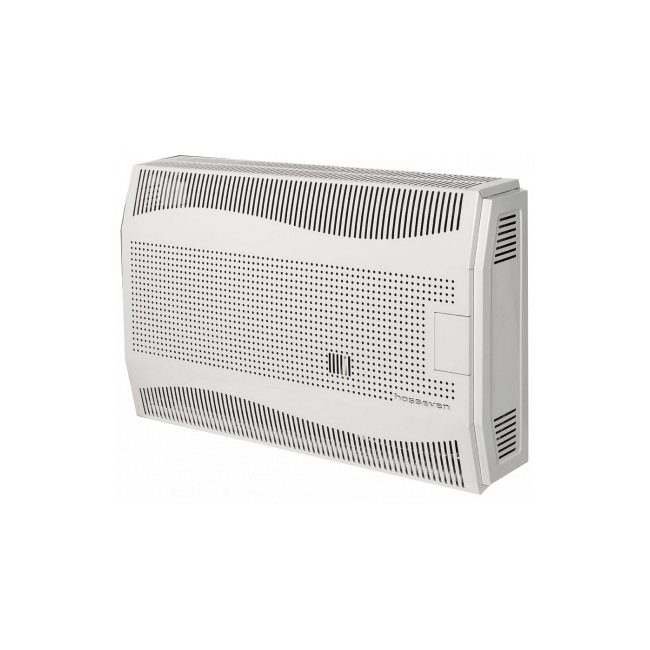
This is the best gas convector heater, which is suitable for a spacious warehouse or gym. Its working area is 160 square meters, and its efficiency reaches 86%, which ensures a comfortable temperature.
The model has a dry-type steel heat exchanger inside, which prolongs temperature retention and saves gas. For start-up and control, there is a hatch on the front panel that provides access to the power button, piezo ignition and temperature regulator.
Pros:
- beautiful appearance of the case, painted with white powder coating;
- compact dimensions 80x27x63 cm will not take up much space;
- ability to operate from a cylinder;
- heat output of 6900 W will quickly warm up a large room;
- easy start by pressing a button;
- thermostat for temperature control;
- gas leakage control;
- built-in gearbox simplifies system layout and first start-up;
- consumes air from the street, so oxygen is not burned indoors;
- wall mount included.
Minuses:
- cost from 20,500 rubles;
- chimney installation required;
- noisy work;
- There is no cylinder included;
- electronics are not protected from moisture;
- 1 year warranty from Turkish manufacturer;
- consumption is about 850g of gas per hour.
READ ALSO
10 Best Oil Heaters
Advantages and disadvantages
The positive features of electric convectors are associated with design and technical features and are tested based on reviews:
- An electric convector allows you to quickly warm up the air masses of a house with different parameters - the power of the device is selected depending on the heated area;
- The electric convector does not require supervision, it is safe for residents of the house;
- Significant energy savings are possible, since the device can be adjusted thanks to the built-in thermostat;
- The design features of the electric convector do not allow creating a fire hazard;
- Electric convector Electrolux, Thermia, Zilon can be installed indoors in a house with a high level of humidity - modern models are safe, even if exposed to splashing water;
- The design of the convector eliminates injuries, since it is made without sharp corners - this allows you to install the electric convector in a children's room;
- The surface of the electrical device does not heat above 65 degrees, so it is impossible to get burned on it;
- The operation of an electrical appliance does not cause unpleasant odors or dry air in the house;
- The electric convector operates silently;
- An electric convector can be installed on almost any surface in premises for various purposes - in a private house, office, apartment.
Positive features of electric floor convectors:
- Mobility during heating;
- Heating efficiency with electric convectors;
- Compactness;
- Heating safety;
- Wide range of power, prices and models from different manufacturers;
- Easy to install and use;
- Durability;
- Electric convectors do not dry the air;
- Features an ergonomic design;
- They look aesthetically pleasing indoors in houses and apartments;
- No odor during operation;
- Safe when exposed to water.
Wall-mounted electric convectors have similar advantages. The difference is that a wall-mounted electric convector is not mobile; it is mounted in a specific place in a specific room of the house. Installation is simple and does not take much time. Can be installed in a private house, non-residential premises, city apartment.
It is worth paying attention to one drawback of electric convectors - the rather high cost of energy consumed, but not economical in terms of electricity consumption.
What determines the amount of payment for electricity?
- From the desired temperature of the air masses in the room that you want to achieve;
- Outdoor temperature;
- Level of insulation of the walls of the room;
- The size and type of windows - the design features of double-glazed windows play an important role.
Types of convectors
Let's see what you need to create convector heating in your home. The finished system can be:
- Water - using convector heating radiators, with pipes and a boiler (electric, gas, solid fuel or liquid);
- Electric – here we mean the installation of electric convectors;
- Gas - special gas convectors are installed in the rooms, most often powered by bottled gas.
Let's talk about these convectors in more detail and find out the distinctive features of certain convector heating systems.
Convector heating radiators
Many people remain adherents of classic heating systems, laying pipes in their houses and installing boilers. If the house has gas, then this is even a plus - after all, water heating based on a gas boiler is the most inexpensive and economical . Approximately the same can be said with regard to heating based on boilers running on liquefied gas. The next leader in terms of efficiency is solid fuel equipment.
Solid fuel boilers can work completely free of charge if you prepare firewood in advance from the nearest forest. If there are no clearings nearby, you can limit yourself to purchasing fuel in bulk - it will be cheaper.
Convector water heating involves the use of radiators connected to pipes laid throughout the house. The hot coolant entering the batteries heats up the metal, after which the heat is transferred to the surrounding air. It rises up, and cold air masses take its place. Temperature control in such heating systems is carried out in a general manner (regulated by the boiler) or privately (using taps and valves on batteries).
Considering the complexity of installation work, we recommend the use of water convector heating in buildings with a large number of rooms - here the installation of dozens of autonomous electric convectors is not justified. It is also recommended for homeowners connected to gas mains and those who have access to inexpensive solid fuel.
Electric convectors
It is very easy to build convector heating based on simple electric convectors. The entire installation process boils down to the following steps:
- Brackets are mounted on the wall;
- Convectors are hung on brackets;
- The equipment is connected to the electrical network.
If we have a miniature country house with one room in front of us, then installation work will take a maximum of half an hour - it is more difficult to extend an outlet to the installation site than to connect a convection device.
Electric convectors operate from the electrical network. Unlike the convector heating batteries described above, they do not contain coolant or any other liquids . Heating here is carried out by finned heating elements installed in the lower part of the heating devices. Air is taken in through the lower slot openings and removed through the upper ones.
The operation of convector heating is controlled by automation - it can be mechanical or electronic. Mechanical thermostats operate on the principle of a bimetallic plate. As soon as the temperature reaches the set value, the plate will bend and open the contact groups. If the air cools down, the opposite will happen - the contacts will close and the heating element will continue to operate. Here it is not the temperature that is set, but the degree of heating (for example, using numbers from 0 to 9).
Electronic thermostats are built on the basis of control modules with sensors, microcircuits and other electronics. They carefully control the air temperature, giving commands to turn the heating elements on/off. This work scheme has the following advantages:
- Convectors receive additional functionality - timers, anti-freeze, program operation, etc.;
- Economical – electronic convectors provide up to 5-10% energy savings;
- Ease of creating a comfortable atmosphere - the temperature can be adjusted with an accuracy of 0.5-1 degrees.
Therefore, we recommend building convector heating on such units. They may be more expensive, but heating efficiency is a priority.
Convector heating based on electric convectors is recommended for use in small and medium-sized non-gas houses. Its main disadvantage is its high cost - you will have to pay several thousand rubles to heat even the smallest house for a month.
Gas convectors
We come to the last equipment from our review - gas convectors. They can operate on both main and liquefied gas. The principle of their operation is very simple:
- A gas burner burns gas to produce heat;
- Under the influence of the flame, the metal radiator begins to heat up;
- The ribbed radiator begins to heat the air;
- Then the simplest convection works - we considered this principle at the very beginning of the review.
Convector heating based on a gas convector cannot be called the most common approach for heating residential buildings. Rather, this is the rarest option, since such units are not widespread.
The gas burner used in such devices requires the removal of combustion products - for this they are equipped with coaxial chimneys that lead directly outside the wall. Accordingly, there are as many chimneys as there are devices in the house. This approach cannot be called optimal, but if the task is to heat a small country house or country house with 1-2 rooms, then this will be the best option . Such equipment is not suitable for heating large houses.
The fuel most often used here is liquefied gas, connected through a flexible hose. If convector heating involves the installation of several gas appliances, we recommend laying a small gas line above the floors to distribute fuel to all convectors. This scheme will allow you to power several gas appliances from one cylinder.
Device
How does an electric convector work? The convector has a fairly simple structure. The design consists of a metal body. The housing contains heating parts. The operation of the heating elements is controlled by a thermostat.
The heating element or heating element ensures the efficient operation of the electric convector. Design of the heating element: housing (made of steel or aluminum) - a sealed structure, which is made in the form of a radiator, a ceramic shell inside the housing with a conductor. The design was created with the goal of heating the air masses in the house as much as possible.
The main advantage is that the convector does not overheat or dry out the air in the room; the air remains fresh, without foreign odors. The heating element can heat up to 100 degrees. To learn how it works, you can watch a video on the Internet.
For device safety, convectors are equipped with special sensors that allow you to regulate the heating temperature.
Heating elements in heaters
Hi all!
Sometimes you look at a convector, it costs about 10 thousand, you expect the latest technologies used by NASA astronauts, you see a super-exquisite design, the kind only to be installed at a reception with the Queen of England at Buckingham Palace, and inside there is a heating element made using technology 50 years ago , the fire hazard of which is quite comparable to playing matches near a gas station.
The trouble is that even old technologies are still used in modern heating devices. How to avoid making the wrong decision and not buying garbage with an obsolete heating element - read here. We've done a quick review of three different heating elements, ranking them from worst to best. It is also appropriate to say that their arrangement in this text goes from old to new (in terms of manufacturability).
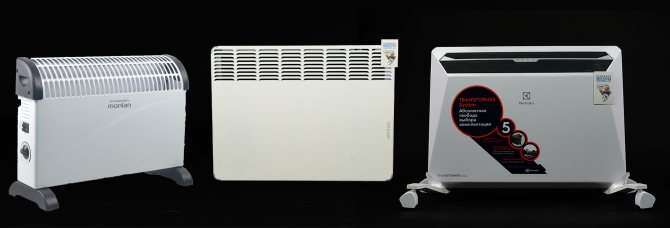
From left to right - Monlan, Atlantic, Electrolux Rapid (inverter convector)
The story will be based on the example of three electric convectors:
- Convector Monlan
- Convector Atlantic
- Inverter convector Electrolux Rapid (with inverter block sample 2020)
Stitch heating element.
Stitch heating element is a steel wire on a dielectric base. Technology that is more than half a century old. The heating element is a metal thread laid in a zigzag. It heats up to a very high temperature (250-300ºC), the air passing through it is warmed up and comes out warm. One of the advantages is instant access to working tº, literally 5-10 seconds. That's where the positives end.
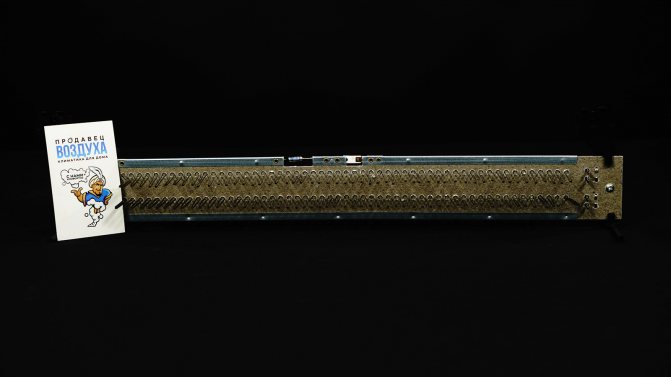
This is what a stitch heating element looks like.
The disadvantages are safety, low efficiency coupled with disproportionate energy consumption, fragility, and discomfort during operation. Safety. A wire that glows red hot. The fire hazard is comparable to playing matches near a gas station. Yes, this metal thread cools down just as quickly as it heats up, but having something at home with an operating temperature of over 300ºC is such an idea. Low efficiency is primarily due to the small area of the heating element. The air that passes through the convection chamber does not have time to heat up sufficiently, since the area of contact with the heating element is very small. Energy consumption is disproportionately high to heat transfer.

The stitch heating element is also known as a needle type. Now you understand why it is called that way)
The area of the heating element must be large, then there will be normal heat removal. So it will heat for a long time, inefficiently, while taking electricity according to its rated power. Discomfort during use is a consequence of the high temperature of the heating element. When dust and other small particles pass by it along with the air (after all, they also participate in the convection mode), they burn, oxygen is oxidized, CO2 is released and a feeling of lack of O2 appears and we begin to smell foreign odors. In fact, there is enough oxygen and it is more than enough, the formation of CO2 is simply destructive, but in this regard you can always install fresh air ventilation and the problem of fresh air will be solved forever.
As for durability, dust and dirt that settle on the heating element when it is turned off burns out instantly, and these sections of the metal thread simply burn out, gradually rendering the device inoperable. This is the most outdated technology, but due to cheaper products, it is often found even in expensive electric convectors.
Steel heating element in an aluminum jacket.
An aluminum jacket is put on the steel tube, which allows heat to be removed from the steel tube and participates in the heat exchange process. The technology is not as old as stitch, but it is also very old. There are no obvious advantages here, but it’s also impossible to say that this heating element is definitely bad. Morally old? Definitely. It was adequate for its time, but now this technology is simply outdated.
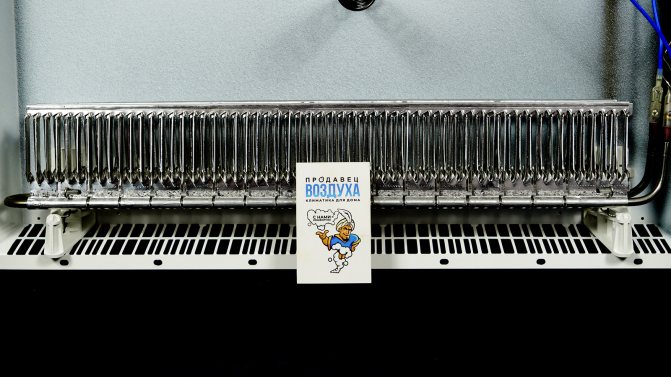
Steel heating element in an aluminum jacket.
Compared to stitch, the operating temperature here is significantly lower, so there is no feeling of O2 burning and foreign odors. The main disadvantage is the operating noise. The heating element consists of two components - a steel tube and an aluminum jacket. The steel tube heats up and transfers heat to the aluminum. Since they have different expansion temperatures, aluminum will expand and contract when heated and cooled, emitting metallic sounds that are really loud, they can wake you up at night, and during work or evening relaxation they can significantly shift your focus from something useful and good for yourself
Monolithic heating element.
Monolith is the most advanced and expensive. Made from a monolithic composition of silumin, which is cast in a single mold. The shape of the heating element is X-shaped, which is why they are often called X-shaped heating elements. Although a V-shaped heating element is also found, it is used in the same baseboard convectors (where an X-shaped heating element would be redundant). Due to the fact that the structure is monolithic, unlike a heating element in an aluminum jacket, it does not cause any clicks or crunches during the heating and cooling process.

Monolithic heating element.
The monolithic structure allows the entire element to be evenly heated to a single temperature and the entire heating element is fully involved in the heat exchange process. The core in the photo above (forming a cylinder in the center) is a heating element and heat is distributed from it to adjacent ribs.
For the sake of truth, it is worth saying that there are many options for monolithic heating elements, but we are showing you the most advanced one that currently exists in the world (at the time of publication); a heating element better than this simply does not exist. The second reason for pride is that our scientists from Izhevsk came up with it, dubbing their development “Turbo-Hedgehog”, since it has a bristly texture and resembles a hedgehog. To make it more convincing, they called him Hedgehog, which also translates as “Hedgehog.”
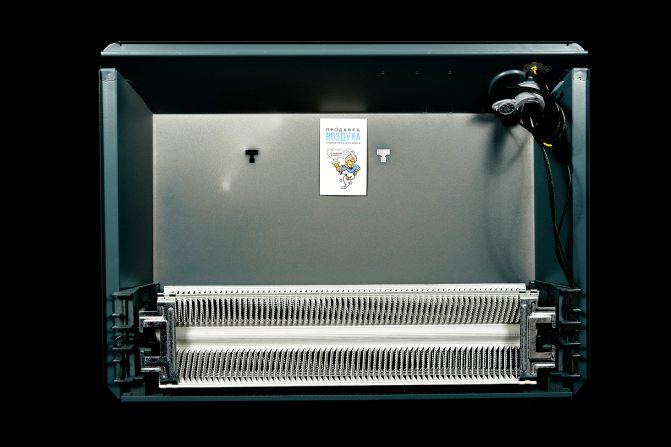
Here is such a compact heating element with as much as 1.5 kW - only 50 cm (while others are at least 64 cm).
It has the largest area, so the largest heat removal occurs here and it warms up the room the fastest. The speed of reaching operating temperature is only 75 seconds. Its operating temperature is the lowest among all heating elements and for high-quality monolithic heating elements does not exceed 125ºC at peak load. They are not afraid of negative temperatures and can be turned on even when they are frozen. The service life of a monolithic heating element is about 25 years, which is a very, very long time.
Let's sum it up: Stitch is the worst. It has the right to exist only in fan heaters, and even then it is better to buy fan heaters with a ceramic heating element. A convector with a steel heating element in an aluminum jacket is morally old, but for some reason someone makes them and uses them, although they are better than stitch. Monolith is the most advanced heating element, but the quality of the monolithic element depends on the manufacturer, since they are all different. If you are now looking for a good heater, we recommend buying an inverter convector. These are the most technologically advanced electric heaters at the moment, inside of which, in addition to having a monolithic heating element installed, inverter control also allows you to save on electricity, optimizing it by an average of 30-35%.
Electrolux Rapid Transformer Inverter Ech/R-1500 T
6 870
Electrolux Rapid Transformer Inverter Ech/R-2000 T
7 570
Electrolux Rapid Transformer Inverter Ech/R-1000 T
6 170
Principle of operation
The convection process occurs according to the laws of physics. The word “convection” means “transfer” - this reflects the principle of operation of an electrical device. The law of physics is simple: cold air sinks, warm air masses rise. Thus, cold air passes through the lower grille of the convector. The air from the grille is heated using special heating elements inside the structure.
After heating, the air gradually rises, and the cooled air descends. This process is constantly repeated, which allows you to maintain the optimal temperature in a private home or other room. When a convector operates, air constantly moves around the house. Videos on the Internet will help you get acquainted with the operating features of convectors.
Electricity consumption calculation
To choose the right electric convector, you need to know the power that is needed to heat the air flow of the room and heat a certain area. How to determine the required power for heating a private house or apartment? The main factor that affects the power level is the area of the room. The larger the room, the more powerful the device is required. An electric convector for heating a private home is a rather expensive heating method.
The table shows the parameters of the room (area in square meters) and the required power level of the electric convector.
| Until 6 | 500 W |
| Up to 9 | 600-750 W |
| Up to 12 | 1000 W |
| 12 — 14 | 1200-1300 W |
| 14 — 17 | 1300-1500 W |
| 18 — 19 | 1700-1800 W |
| 20 — 23 | 1900-2000 W |
| 24 — 27 | 2300-2500 W |
Knowing the area of the room, you can buy an electric convector from various manufacturers at different prices. If the device is chosen incorrectly, you will not get the desired result.
How to choose an electric convector for a private home: expert advice
Before purchasing an electric converter, you must remember that this is an effective, convenient, but quite expensive way to heat the air flow in a room. You can read customer reviews. Different converters vary in power. Electric convectors for heating a private home will help create a high-quality and economical heating system.
How to calculate the power of a device for a room?
To correctly select the power of an electric convector for a private house or apartment, there is a formula: 1 kW of converter power warms up a room of about 10 square meters with a ceiling height of up to 3 meters.
Electric convectors with the following performance are available on the market:
- 0.5 kW;
- 1 kW;
- 1.25-1.5 kW;
- 2 kW.
A 2.0 kW electric convector is suitable for a large room.
How to calculate the power needed to heat a house?
The average private country house consists of: a bedroom, a dining room-kitchen, an entrance hall, a bathroom, a living room, and a children's room. Accordingly, the area of each room in a private house in square meters: 10, 12, 5, 5, 20, 12. Summing up these indicators, we get 64 sq.m. It is known that a room with an area of 64-70 sq.m. requires a performance of electric convectors of 7 kW, based on the formula described above. Thus, based on these calculations, you can choose the number and power of converters for heating.
The most important selection factor is the heating element. The duration of operation of the electric convector depends on the quality of this element. It is recommended to choose a device with a ceramic heating element. Modern converters are all safe for installation in the bathroom and kitchen - internal parts are protected from water ingress.
When choosing a converter for a private home, you should pay attention to:
- Manufacturer - models from Thermia, Electrolux, Zilon, Neurot are distinguished by a wide selection of options;
- Material for manufacturing structural parts;
- Power, performance of the electric convector;
- Type: universal, wall or floor;
- Price;
- Dimensions of the electric convector;
- The presence or absence of special operating modes;
- Design - if necessary, you can buy converters made not only in white, which will better fit into the interior of a private house or apartment.
Tips for choosing convectors
- Room up to 6 sq.m.
The main indicators of heating with electric convectors will be: dimensions, power, type of installation and customer reviews. Sufficient power – 500 W. The dimensions of the model should be compact. The type depends on the number of heated rooms in a private house or apartment: you can install a wall-mounted heating option or choose a mobile, economical floor converter that can be moved from room to room.
Electrolux ECH/L - 500 U - a universal convector model with a power of 500 W.
- Room up to 9 sq.m.
Sufficient power – about 750 W. You can buy lightweight, convenient, economical electric convectors of small dimensions. Ballu Сamino Electronic BEC/E – 1500 is an inexpensive, universal electric convector, which is characterized by excellent reviews, the presence of two operating modes, and noiselessness. A wall-mounted convector can be used in rooms with high humidity levels.
Photo of wall-mounted electric convector
- Room up to 12 sq.m.
This is the standard size of a bedroom or children's room. 1000 W is enough. Electrolux ECH/L – 1000 U – universal type convector with a power of 1000 W. It is characterized by the presence of protection against overheating, the ingress of foreign objects into the device, and good reviews. For small rooms, electric convectors Thermia and Evub are also recommended.
- Room up to 14 sq.m.
1200-1300 W will be enough for you. Noirot Spot E-2 7358-4 is an economical model that is suitable for heating such a room. The advantage of the model is that it is a universal type convector that can be installed on a wall or on the floor and is inexpensive. Characterized by accuracy, high quality workmanship, and according to reviews - economical.
- Room more than 15 sq.m.
Requires a power of 1500 W or more. A decent economical option is Noirot Melodie Evolution 7381-5. Skirting-type convector with a power of 1500 W. Heating with electric convectors is characterized by automatic protection against overheating, operates silently, and is equipped with many useful functions. Buyers give excellent reviews.
Photo of wall-mounted electric convector
The operating principle of a convector heater is to maintain a stable temperature
On this topic:
Choosing a gas heater for a winter tent
How to make the right choice of electric heater
Making your own heater from clay pots
Heating pipes - we take into account the advantages and...
BACK FORWARD 1 of 15
If the cold air entering the heater is at a high enough temperature, the electric current is temporarily turned off. This process is monitored by electronics. There is a temperature sensor on the body; the information is transmitted to an automatic device that turns the electrical current on or off. This system prevents overheating of the air in the room. Some types of heaters have a digital indicator that displays the room temperature.
How does a convection heater work in autumn and winter?
The maximum power of a convector heater is 2 kW. This is enough to maintain a comfortable temperature in a room of no more than 20 square meters, provided that the temperature outside the window does not drop below zero. This heater is effective during autumn temperature drops.
In winter, during frosts, a power of 2 kW is not enough to heat the room. A convection heater will not replace central heating, but can serve as an additional source of heat during frosty weather.
In addition to power, the volume of circulating air plays an important role for this type of heater. You need to remember how a convection heater works: air in the room must pass through it during circulation. It is generally accepted that for every ten square meters 1 kW of heater power is required. If the room has an area of more than 20 square meters, then one heater is not enough - there must be at least two.
Can heating efficiency be improved by installing tightly closing windows and doors? In general, heating the air will become more efficient, but hygienic standards for the composition of the air may be violated. The problem is that a certain volume of air cannot constantly be present in a living room; ventilation is required. With an area of 20 square meters, an hourly exchange of 20 cubic meters of air is required. If the air entering the room passes through the convector, then people will not feel a sharp cooling in the room.
Construction and design of convector heaters
Convector heaters look like flat panels. They have a significant lateral surface and small thickness. Structurally, these devices are divided into wall-mounted and floor-mounted.
The wall-mounted option saves space. The pleasant light color of the body ensures that the heater fits naturally into the interior. The floor design has its advantages: the heating panel is mounted on wheels, the heater can be moved around the room.
Video about the operating principle of heaters (from 3.30 min)
Installation and installation of electric convector
Installing an electrical converter does not require much time and effort. This procedure, entrusted to specialists, will take no more than an hour. Installing a floor model in your home takes even less time.
The main thing that is required when installing an electric convector is the installation of each panel, provided that each panel is autonomously powered. It is important to choose the correct wire cross-section - this factor depends on the power of the device:
- Up to 1.5 kW – 1.5 sq.mm;
- More than 2.0 kW - 2.5 sq. mm.
Specialists lay the conductor and connect it to the circuit breaker. Connects directly from the panel house. Additionally, circuit protection using an RCD is required. The most popular are 2.0 kW electric convectors - universally suitable for large rooms for various purposes.
Prices for electric convectors
Prices for electrical converters depend on design features, functionality, and manufacturer. You can buy converters at affordable prices in online stores with delivery or at specialized sales points. Inexpensive convectors are also of high quality. Customer reviews are the best recommendation. You can see a photo of the device in the table.
| Brand | Model | Price | Photo |
| Economical electric convectors FEST | CNR10K1 | 1150 | |
| Electric convector Evub | Evub 0.5/220 | 1670 | |
| Economical electric convectors FEST | CNR20K1 | 1760 | |
| Electric convectors for home heating BEC | M - 1500 | 2290 | |
| Electric convectors for home heating Ballu | BEC/EZMR-1000 ENZO series with mechanical thermostat | 2500 | |
| ZILON | ZHC-1000 SR2.0 Comfort 2.0 | 2550 | |
| Economical electric convectors RODA | Standard 0.5 | 2800 | |
| ELECTROLUX | ECH/AG - 1000 MF (Air Gate) | 3600 | |
| DANTEX | Digital SD4-10 | 4550 | |
| Economical electric convectors Ballu | Platinum BEC/EVE – 1500 with electronic thermostat | 5350 | |
| Noirot | CNX-2 500 | 5400 | |
| Electric convectors for heating Ballu | BIHP/R-1500 | 5900 | |
| Electric convector NOBO | C4E05 (Nordic) wall-mounted electric convector | 6900 | |
| Electric convectors for heating ELECTROLUX | ECH/AG2 - 2000 EF (Air Gate 2) | 7500 | |
| ELECTROLUX | EIH/AG2-2000 E | 7700 | |
| Electric convector NOBO | C4E20 (Nordic) wall-mounted electric convector | 10000 |
